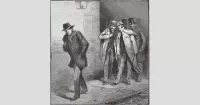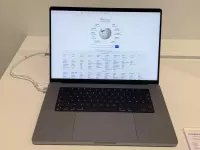Patricia Cornwell is a renowned American crime writer best known for her Kay Scarpetta series, which revolves around a medical examiner and emphasizes forensic science. Her work, often set in Richmond, Virginia, has significantly impacted the portrayal of police work in television. Cornwell has also conducted research into the Jack the Ripper case, controversially suggesting Walter Sickert as the perpetrator. Her books have achieved immense popularity, selling over 120 million copies worldwide.
1961: Father leaves family
In 1961, Patricia Cornwell's father left the family on Christmas Day, an event she attributes to emotional abuse she suffered.
1961: Family moves to North Carolina
In 1961, Patricia Cornwell's mother, Marilyn, moved with her three children to Montreat, North Carolina. The family was taken in by Ruth Bell Graham, who arranged for Cornwell to be raised by Lenore and Manfred Saunders.
1979: Reporter for The Charlotte Observer
In 1979, Patricia Cornwell began her career as a reporter for The Charlotte Observer, starting with TV listings, then features, and finally covering crime.
1979: Graduation from Davidson College
In 1979, Patricia Cornwell graduated from Davidson College with a B.A. in English, after briefly attending King College and transferring to Davidson on a tennis scholarship.
June 14, 1980: Marriage to Charles Cornwell
On June 14, 1980, Patricia Cornwell married Charles L. Cornwell, one of her professors, shortly before her graduation.
1980: Investigative Reporting Award
In 1980, Patricia Cornwell received the North Carolina Press Association's Investigative Reporting Award for a series on prostitution.
1981: Moves to Richmond, Virginia and starts biography
In 1981, Patricia Cornwell moved to Richmond, Virginia, with her husband, Charles, and began working on the biography of Ruth Bell Graham.
1983: Publication of Ruth Bell Graham biography
In 1983, Patricia Cornwell's biography of Ruth Bell Graham, "A Time for Remembering: The Ruth Bell Graham Story" (later renamed "Ruth, A Portrait: The Story of Ruth Bell Graham"), was published.
1984: Starts first novel
In 1984, Patricia Cornwell started working on her first novel featuring a male detective and met Dr. Marcella Farinelli Fierro, who would later inspire the character of Dr. Kay Scarpetta.
1985: Job at the Office of the Chief Medical Examiner
In 1985, Patricia Cornwell began working at the Office of the Chief Medical Examiner of Virginia, first as a technical writer and later as a computer analyst.
1985: Gold Medallion Book Award
In 1985, Patricia Cornwell's biography of Ruth Bell Graham received the Gold Medallion Book Award from the Evangelical Christian Publishers Association.
1987: Stranglings in Richmond
In the summer of 1987, real-life stranglings occurred in Richmond, inspiring Patricia Cornwell's first Scarpetta novel.
1989: Relationship with Marguerite "Margo" Bennett
In 1989, Patricia Cornwell had a relationship with FBI agent Marguerite "Margo" Bennett, which gained media attention after Bennett's husband attempted to kidnap her.
1989: Separation from Charles Cornwell
In 1989, Patricia Cornwell separated from her husband, Charles Cornwell; she retained her married name after the divorce.
1990: Publication of Postmortem
In 1990, Patricia Cornwell's first Scarpetta novel, Postmortem, was published, based on real-life stranglings. It won her various awards.
January 10, 1993: Drunk driving conviction
On January 10, 1993, Patricia Cornwell was convicted of drunk driving after crashing her Mercedes-Benz, and was sentenced to 28 days in a treatment center.
1998: Publication of The Virginia Ghost Murders
In 1998, Leslie Sachs published "The Virginia Ghost Murders".
1998: Political Donations
Since 1998, Patricia Cornwell has donated at least $84,000 to the Republican Party and $78,800 to the Democratic Party, and made individual contributions to various Senate candidates.
1999: Private helicopter license
In 1999, Patricia Cornwell received her private helicopter license.
2000: Plagiarism accusations by Leslie Sachs
In 2000, Leslie Sachs accused Patricia Cornwell of plagiarism, alleging similarities between his novel, "The Virginia Ghost Murders", and her novel, "The Last Precinct".
2000: Style shift in Scarpetta novels
In 2000, starting with "The Last Precinct", Patricia Cornwell's Scarpetta novels shifted in style from past tense to present tense.
2001: Criticism for destroying painting
In 2001, Patricia Cornwell was criticized for allegedly destroying one of Walter Sickert's paintings in pursuit of her theory that he was Jack the Ripper.
2002: Publication of Portrait of a Killer
In 2002, Patricia Cornwell published "Portrait of a Killer: Jack the Ripper—Case Closed", supporting her theory that Walter Sickert was Jack the Ripper.
2003: Change in narration
In 2003, starting with "Blow Fly", the style of Patricia Cornwell's Scarpetta novels changed from a first-person to a third-person, omniscient, narrator.
2004: Financial Management Assigned
In 2004, Patricia Cornwell assigned management of her financial matters to Anchin, Block & Anchin, managed by Evan Snapper, at a base rate of $40,000/month.
2006: Marriage to Staci Gruber
In 2006, Patricia Cornwell married Staci Gruber, an associate professor of psychiatry at Harvard University.
2007: Public disclosure of marriage
In 2007, Patricia Cornwell disclosed her marriage to Staci Gruber and spoke about the importance of advocating for equal rights.
2007: Libel Suit Testimony
In 2007, during her libel suit against Leslie Sachs, Patricia Cornwell testified that Sachs had accused her of various defamatory claims online. The court permanently stopped Sachs from making defamatory accusations and awarded Cornwell $37,780 in damages.
2008: Speaks about bipolar disorder
In 2008, Patricia Cornwell spoke openly about her struggle with bipolar disorder.
July 2009: Cornwell Fired Financial Firm
In July 2009, Patricia Cornwell fired Anchin, Block & Anchin after discovering financial mismanagement, leading to a lawsuit.
2010: Shift back to first-person
In 2010, Patricia Cornwell shifted back to a first-person perspective in the Scarpetta novel "Port Mortuary".
January 2013: Lawsuit opened
In January 2013, the court case opened, with Patricia Cornwell suing Anchin, Block & Anchin for $100 million due to financial mismanagement.
2015: Misdiagnosis
In 2015, Patricia Cornwell revealed that she had been misdiagnosed with bipolar disorder.
2017: Publication of Ripper: The Secret Life Of Walter Sickert
In 2017, Patricia Cornwell published "Ripper: The Secret Life Of Walter Sickert", furthering her quest to prove that Walter Sickert was Jack the Ripper.
Mentioned in this timeline
Virginia officially the Commonwealth of Virginia is a state located...

Miami is a major coastal city located in Florida United...
North Carolina is a Southeastern U S state the th-largest...
Florida a state in the Southeastern United States is largely...

Books are a means of storing information as text or...

Jack the Ripper was an unidentified serial killer active in...
Trending

2 months ago Natalie Portman: Ahsoka Season 2 Theory, Miss Dior Essence, AI Actress Controversy.
2 months ago Sleep Token Accused of IG Shutdown Over Tattoo Copyright: Artist Claims Label Involved

26 days ago MacBook Pro M5 Issues Reported; Amazon Offers Black Friday Deals on MacBooks.

7 months ago Trae Young Trolls Knicks Fans During NBA Playoffs: A Playful Jab.

1 month ago Kris Jenner Ringleader as Khloé Kardashian Wears Care Bears Halloween Costume: Family Celebrates

1 month ago Russian Drone Attack Ignites Gas Tanker Blaze Near NATO Border After US Gas Deal
Popular

Candace Owens is an American conservative political commentator and author...

Ilhan Omar is an American politician currently serving as the...

XXXTentacion born Jahseh Dwayne Ricardo Onfroy was a controversial yet...

Tucker Carlson is an American conservative political commentator known for...

Bill Gates an American businessman and philanthropist revolutionized personal computing...

Charles James Charlie Kirk was a prominent American right-wing political...






